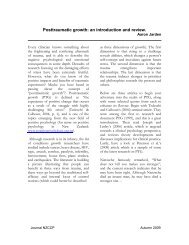The expert therapist - Aaron Jarden
The expert therapist - Aaron Jarden
The expert therapist - Aaron Jarden
Create successful ePaper yourself
Turn your PDF publications into a flip-book with our unique Google optimized e-Paper software.
offer different subject positions, which entail different rights, obligations and<br />
possibilities for action. Hence, subject positions have implications for power<br />
relations as they constrain and shape what an individual can do. In other<br />
words, each individual is exposed to an interaction of different discourses,<br />
each with its own possible subject positions, structure of rights, obligations<br />
and possibilities for action, and each carrying different power implications.<br />
APPLYING POSITIONING THEORY: FROM THEORY TO PRACTICE<br />
With regard to positioning theory, we were interested in the ways<br />
cognitive <strong>therapist</strong>s utilised different discursive strategies and repertoires to<br />
position themselves and their clients, and the various effects the positioning<br />
had for the therapeutic process. In order to determine the various positioning<br />
that was happening in the interactions, our focus was on the way <strong>therapist</strong>s<br />
used particular strategies to present and describe themselves and others, as<br />
well as the „structure of rights‟ entailed by the positions.<br />
For the purposes of this article, we have chosen to focus on the two<br />
main and most frequently adopted positions discerned in the therapeutic<br />
process; the <strong>therapist</strong> as the „<strong>expert</strong>‟ and the client as the „layperson‟. We<br />
have also chosen to outline only three of the most common discursive<br />
strategies and a repertoire that was used to enable and support this particular<br />
positioning. <strong>The</strong>se three discursive strategies included the way <strong>therapist</strong>s<br />
imparted knowledge, made extreme cases, and concealed information from<br />
their clients. <strong>The</strong> supportive repertoire was a moral repertoire which alluded to<br />
the <strong>therapist</strong>s as moral <strong>expert</strong>s. <strong>The</strong>se strategies and this repertoire were tied<br />
to practices which supported and maintained positions of power and<br />
dominance for the <strong>therapist</strong>s, to which they then utilised for therapeutic effect.<br />
POSITIONING OVERVIEW<br />
When <strong>therapist</strong>s were conversing with other <strong>therapist</strong>s or clients, they<br />
frequently adopted and became enmeshed in the subject position of an<br />
„<strong>expert</strong>‟. From this position, the <strong>therapist</strong>s warranted all the rights,<br />
responsibilities, standards, reputations, and entailments usually given to or<br />
assumed by an <strong>expert</strong>. In more practical terms, adopting this position provided<br />
therapeutic credibility, validated their accounts, and established various<br />
„medical powers‟ relevant to the therapeutic change process.<br />
From this „<strong>expert</strong>‟ position, <strong>therapist</strong>s frequently positioned their clients,<br />
and their clients adopted (although we do not explicitly cover this aspect), the<br />
opposite subject position of „layperson‟. In this position, the clients were<br />
passive, sub-optimal and deficient of knowledge and skill, entailing a<br />
somewhat diminished status. In more practical terms, the client was afforded<br />
lesser rights to make decisions, have input into and control over the therapy<br />
process, and afforded less ability to use and converse in relevant<br />
psychological terminology, and the positioning that entailed from this usage.<br />
METHODOLOGY<br />
<strong>The</strong> multi-media approach of this research involved obtaining three<br />
distinctly different types of talk and text from within the cognitive therapy<br />
domain. <strong>The</strong>se consisted of cognitive therapy instructional books, cognitive<br />
therapy demonstration videos, and interviews with practicing cognitive<br />
3





